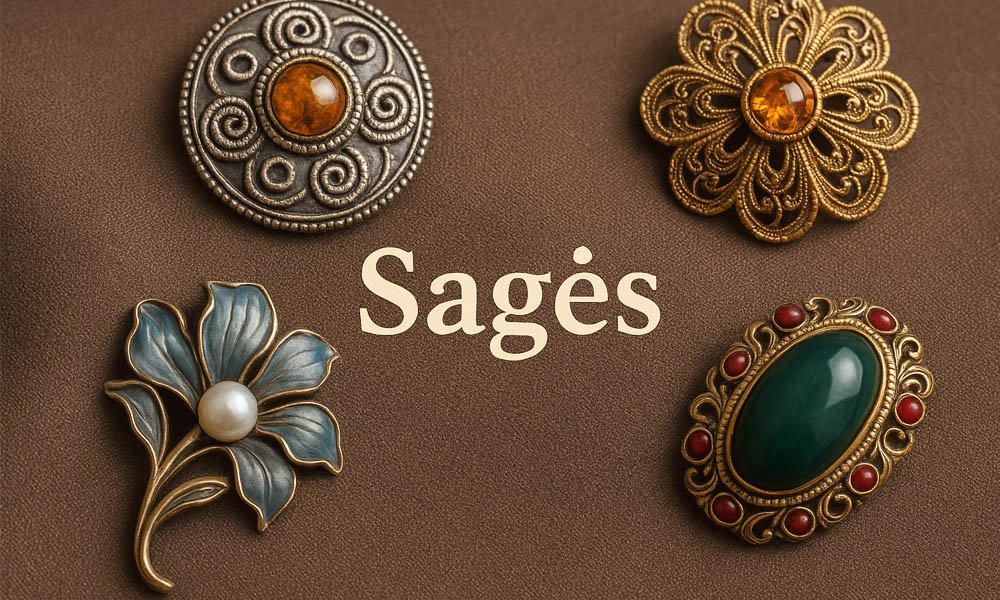Guide
Sagės: The Beautiful Pins with a Hidden Story
Published
5 months agoon
By
Archie
Have you ever seen a small shiny pin on someone’s coat or dress and thought, “That looks so pretty”? That little pin might be a sagė. In Lithuania, sagės are more than just pretty brooches — they are full of meaning, history, and style.
Sagės have been around for thousands of years. People used them not just to decorate their clothes, but also to show who they are, where they come from, and even what they believe. Today, sagės are coming back. More and more people are using them to add a personal touch to their outfits.
In this article, we’ll explore everything about sagės — what they are, where they come from, what they mean, and why they’re still so popular today. Let’s get started.
What Are Sagės?
Sagės are decorative pins or brooches that people wear on their clothes. They are usually made from metal like silver, bronze, or gold. Some have beautiful stones, enamel, or even tiny pieces of glass. The word sagė is Lithuanian and simply means “brooch” in English.
These pins are often used to hold fabric together or just to look nice. Some are very simple, while others are full of tiny designs and patterns. They can be round, spiral-shaped, shaped like animals, or even look like little suns.
Sagės are not just jewellery — they often show something about the person wearing them. They might tell you where someone is from, what they believe, or remind them of someone they love.
Where Did Sagės Come From?
Sagės have a very old story. Long ago, before people had buttons or zippers, they used sagės to fasten their clothes. In ancient Europe and the Baltic region, people made pins called fibulae. These were early versions of sagės — like old-fashioned safety pins, but more beautiful.
In Lithuania, sagės started to become special during the Iron Age. This was about 2,500 years ago. People began making sagės not just for use, but also to show meaning. They added symbols like spirals, suns, and animals. Some sagės were believed to protect people from bad energy or to show what tribe they belonged to.
As time went on, sagės became even more detailed. They weren’t just for holding clothes anymore. They became a way to express who you are.
Sagės in Lithuanian Culture
In Lithuanian traditions, sagės have always been important, especially for women. When women wore folk costumes, they often added big, beautiful sagės to the chest or neck. These pins were not just decorations. They held the clothes in place and also showed beauty, status, and connection to nature or beliefs.
Each part of Lithuania had its own special sagės styles. For example:
-
In Aukštaitija, sagės had sun shapes to show eternal life.
-
In Žemaitija, they had triangles and crosses for protection.
-
In Suvalkija, the pins had tree and flower patterns.
-
In Dzūkija, sagės showed animals or abstract shapes, often with deep meanings.
Sagės were often passed down from mothers to daughters. They were seen as gifts full of love, wisdom, and protection. So when someone wore a sagė, it wasn’t just about fashion — it was about family, history, and respect for tradition.
What Do Sagės Mean?
Every sagė tells a story. The symbols used in them can have powerful meanings. For example, spirals often mean a life that never ends. Suns can mean light or protection. Trees and flowers show a deep connection to nature. Some sagės even have animals that act like spiritual guides.
Back then, when someone saw your sagė, they could learn something about you. It might show where you were from, if you were married, or what you believed. It was like wearing a little badge of identity — but one that was also beautiful.
Even today, many people still wear sagės with special meanings. Some wear them to feel close to their culture. Others wear sagės to remember someone special. And some just love the design and want to wear something unique.
Types of Sagės Through History
Over the years, sagės have changed a lot. Different styles appeared at different times and in different places. Here are some of the most common types:
1. Fibulae: These were the earliest sagės. They looked like safety pins and were used to fasten cloaks or robes.
2. Spiral Sagės: Made of coiled wire, often shaped like suns or wheels. These were very common in old Baltic cultures.
3. Disk Sagės: These were round, flat sagės with carved or stamped designs. Many were worn during the Middle Ages.
4. Animal-Shaped Sagės: Some sagės looked like birds, snakes, or deer. People believed these animals had power or brought protection.
5. Religious Sagės: After Christianity spread, sagės often had crosses or images of saints.
6. Fancy Fashion Sagės: In the 1800s and 1900s, sagės became big in women’s fashion. Some were covered in gems and made to match dresses.
These many styles show how sagės were never just one thing. They changed with the world — and they’re still changing today.
Sagės in Traditional Clothing
In many Lithuanian villages, folk costumes were worn for dances, weddings, and holidays. And sagės were a key part of that clothing. Most sagės were placed on the chest, holding scarves or cloth pieces together. But they also acted like jewellery — the centre of attention.
Women often wore large sagės with detailed designs that matched their region. Each pin was carefully made by hand and sometimes even blessed. The design, the metal, and even the size of the sagė could say something important about the person wearing it.
One sweet tradition was for mothers to give their sagė to their daughter before marriage. It was like passing down protection and family love. That sagė could stay in the family for many generations, becoming a quiet witness to family stories and changes.
Sagės in Today’s Fashion
Fashion always changes, but some things come back in style — and sagės are one of them. In 2025, many people are wearing sagės again. Not just in Lithuania, but all over the world.
Modern designers love to play with old ideas. They use sagės in new ways, like on jackets, scarves, or even bags. Some sagės are big and bold, while others are small and simple. No matter the size, they help people show their personal style.
Sagės are now seen in both streetwear and high fashion. They’re used in runway shows, music videos, and everyday outfits. This shows that something so old can still feel fresh and exciting today.
Famous People Wearing Sagės
Sagės are not just for traditional events anymore. Many celebrities wear them on the red carpet or at big events. Some choose vintage sagės, while others go for modern designs.
For example, artists like Harry Styles or Billy Porter have been seen wearing brooches on suits. Their looks are stylish, bold, and help break fashion rules in a fun way.
Even Queen Elizabeth II, who passed away in 2022, had a huge collection of sagės. She wore them at important moments — each one had a meaning. This inspired many people to start looking at sagės not just as jewelry, but as personal symbols.
How to Wear a Sagė Today
There are so many fun and stylish ways to wear a sagė. You don’t need a traditional costume or a fancy event to enjoy it. You can wear a sagė with clothes you already have.
Here are a few easy ideas:
-
On a blazer: Add a sagė to your jacket lapel to make it stand out.
-
On a scarf: Use a sagė to hold a silk scarf together — it looks classic and smart.
-
On a hat or bag: Pin a sagė to your cap or tote bag for a creative touch.
You can even mix old and new. Try wearing a vintage sagė with jeans or a modern sagė with a traditional outfit. It’s all about expressing yourself.
Where to Find or Make Your Own Sagė
If you want your own sagė, you have lots of options. You can buy one or even make one yourself.
To buy:
-
Check local craft markets or cultural festivals.
-
Look online on websites like Etsy or vintage shops.
-
Visit museums or galleries that support handmade jewellery.
To make:
-
Use an old earring, button, or small object.
-
Add a pin back from a craft store.
-
Glue the pieces together and make your own one-of-a-kind sagė.
Making a sagė at home is a fun way to show creativity. Plus, it makes your outfit feel even more personal.
How to Care for Your Sagės
Taking care of your sagės is important if you want them to last.
Here are some simple tips:
-
Keep sagės in a dry box, away from water and sunlight.
-
Don’t mix them with other jewelry, so they don’t get scratched.
-
Use a soft cloth to clean them gently. Avoid using strong chemicals.
If your sagė is old or very delicate, it’s best to ask an expert how to clean it. This helps protect the design and metal.
Why Sagės Still Matter in 2025
In a world full of fast fashion, sagės feel different. They are not just something you wear and forget. They have meaning. They connect you to your past, your family, your culture, or even your own story.
Wearing a sagė today is not just about looking nice. It’s about choosing something with purpose. Whether it’s made by your grandmother or a local artist, each sagė carries a little piece of someone’s life.
Sagės reminds us that style doesn’t have to be loud. It can be quiet, simple, and full of heart. And that’s why they are so special — and why they are still loved today.
Conclusion
Sagės are more than just small pins. They are full of history, beauty, and meaning. They have been worn by ancient people, queens, artists, and everyday dreamers. And now, they are finding a new place in the modern world.
If you’ve never worn a sagė before, maybe now is the time to try. Whether you buy one, find one, or make your own, you’re not just adding to your outfit. You’re becoming part of a story that started thousands of years ago… and is still going strong.
So the next time you see a sagė, take a closer look. There might be more to it than meets the eye.
(FAQs)
Can a single sagė be older than 2,000 years?
Yes! Some sagės found in the Baltic region are over 2,500 years old and still perfectly shaped.
Did people really use sagės instead of buttons?
Absolutely. Before buttons and zippers were invented, sagės were the main way to fasten clothes.
Are sagės only for women?
No! Historically, men — including warriors and kings — proudly wore sagės to show power and status.
Can sagės protect you spiritually?
In ancient times, sagės were believed to keep away evil spirits and bring luck or protection.
Is it true that sagės are now used in protest art?
Yes. Some modern artists use recycled materials to make sagės that speak out against fast fashion and climate change.
Other Articles You May Read:
You may like


Benefits of Partnering with an Expert Foundry

Choosing the Right Supported Independent Living Option for Your Needs

Why Companies Worldwide Are Hiring Power BI Developers

Experience Pure Android Gameplay with MuMuPlayer Emulator

A Guide To Solar PV For Homeowners

How to Convert a Historic Building into a Hotel: a 2025 Guide

How You Can Integrate AI into Your Small Business For Faster Growth

File Recovery on Android: Myths vs. Facts

Cooler, Safer, Clearer: Why Quality Window Tint Is a Smart Upgrade in 2025

How Medium-Sized Businesses Actually Handle Their Books

Carol Kirkwood’s Journey: Her Real Age, Husband, Career, and More

Revolutionizing Healthcare: The Emergence of AI-Driven Analytics

How Machine Learning and AI are Redefining the Future?

Aliza Barber: Meet Lance Barber’s Wife, Age, Life, Profile, Career and Net Worth

Evelyn Melendez: Jordan Knight’s Wife Bio, Marriage, Family, Career and Net Worth

Ilan Tobianah Biography: Family, Marriage, Lifestyle, Career and Net Worth

Who was Alice Marrow? Everything to Know About Ice-T’s and His Mother

King Von’s Autopsy Report: The Truth Behind the Tragic Death

Meet Otelia Cox: The Supportive Wife of Tony Cox – A True Fairy Tale Romance

Tea Leoni and Tim Daly Split – A Closer Look at Their Relationship and Breakup

Benefits of Partnering with an Expert Foundry

Choosing the Right Supported Independent Living Option for Your Needs

Why Companies Worldwide Are Hiring Power BI Developers

Experience Pure Android Gameplay with MuMuPlayer Emulator

A Guide To Solar PV For Homeowners

How to Convert a Historic Building into a Hotel: a 2025 Guide

How You Can Integrate AI into Your Small Business For Faster Growth

File Recovery on Android: Myths vs. Facts

Cooler, Safer, Clearer: Why Quality Window Tint Is a Smart Upgrade in 2025

How Medium-Sized Businesses Actually Handle Their Books
Category
Trending
-

 News3 months ago
News3 months agoCarol Kirkwood’s Journey: Her Real Age, Husband, Career, and More
-

 Health2 years ago
Health2 years agoRevolutionizing Healthcare: The Emergence of AI-Driven Analytics
-

 Technology2 years ago
Technology2 years agoHow Machine Learning and AI are Redefining the Future?
-

 Celebrity2 years ago
Celebrity2 years agoAliza Barber: Meet Lance Barber’s Wife, Age, Life, Profile, Career and Net Worth
